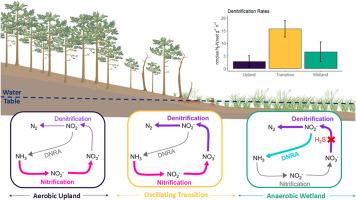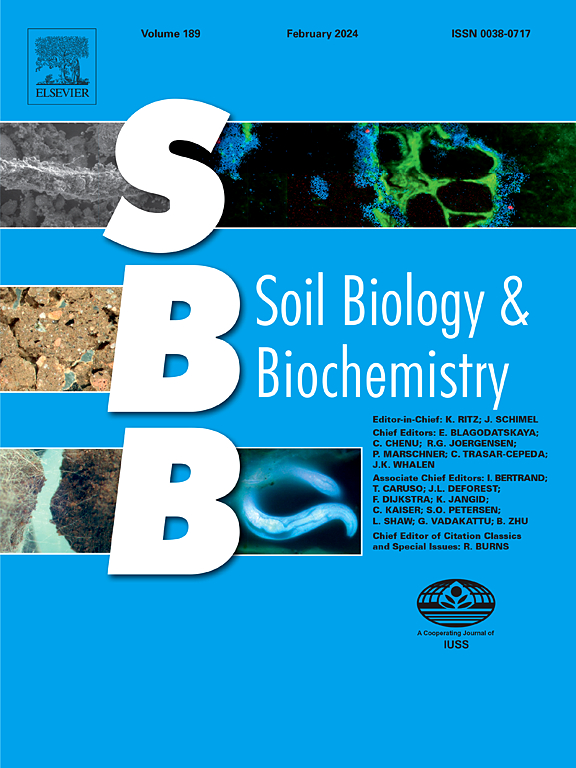Nitrate reduction across soils transitioning from coastal forest to wetland are hotspots for denitrification
IF 10.3
1区 农林科学
Q1 SOIL SCIENCE
引用次数: 0
Abstract
Sea level rise drives spatial migration of coastal ecosystems and can lead to the accelerated replacement of coastal forests with tidal wetlands. During this transition, changes in inundation frequency and saltwater intrusion dramatically alter soil biogeochemistry and redox conditions. Soil biogeochemical cycles in steady-state upland and wetland ecosystems are well studied, but pathways and rates in rapidly changing ecosystems are largely unconstrained. We characterized reduction of reactive nitrogen (N) via denitrification and dissimilatory nitrate reduction to ammonia (DNRA) at four sites where coastal forest is undergoing ecosystem state change and becoming wetland throughout the Chesapeake Bay. Sites were chosen to vary in soil characteristics, vegetation, and salinity regime. Soils were incubated with 15N-labeled nitrate to estimate potential rates of denitrification and DNRA. Denitrification rates ranged from 0.011 to 26 nmol N g−1 hr−1 and DNRA rates ranged from −0.30 to 5.6 nmol N g−1 hr−1. DNRA rates were low with no clear pattern across the sites. Denitrification rates were higher in transition zone soils than in upland soils at three of the four sites (p < 0.05). Rates of denitrification in wetlands were lower than that observed in transition soils when hydrogen sulfide (H2S) concentrations were high, favoring DNRA, but not where H2S was low. Rates of denitrification across sites and zones were driven by soil moisture and related to organic matter content. Our data suggest that transition zone soils act as hotspots for N removal due to intermittent inundation and oscillating redox conditions. The N cycling characteristics of soils changing from forest to wetland are unique enough from steady-state upland and wetland ecosystems to address as a distinct ecotone in forecasts of future ecosystem function and N exchange at the coastal terrestrial-aquatic interface.


沿海森林向湿地过渡过程中土壤硝酸盐的减少是反硝化研究的热点
海平面上升推动了沿海生态系统的空间迁移,并可能导致沿海森林被潮汐湿地加速取代。在这一转变过程中,淹没频率和盐水入侵的变化极大地改变了土壤的生物地球化学和氧化还原条件。土壤生物地球化学循环在稳定的高地和湿地生态系统中得到了很好的研究,但在快速变化的生态系统中,途径和速率在很大程度上是不受限制的。在切萨皮克湾沿海森林发生生态系统状态变化并成为湿地的四个地点,研究了通过反硝化作用和异化硝酸盐还原成氨(DNRA)来减少活性氮(N)的特征。地点的选择取决于土壤特征、植被和盐度。土壤与15n标记的硝酸盐孵育,以估计潜在的反硝化和DNRA速率。反硝化速率范围为0.011 ~ 26 nmol N g-1 hr-1, DNRA速率范围为-0.30 ~ 5.6 nmol N g-1 hr-1。DNRA发生率低,各部位无明显规律。4个样点中有3个过渡带土壤的反硝化速率高于旱地土壤(p <;0.05)。当硫化氢(H2S)浓度高时,湿地的反硝化速率低于过渡土壤,有利于DNRA,但在H2S浓度低时则相反。不同地点和区域的反硝化速率受土壤湿度驱动,并与有机质含量有关。我们的数据表明,过渡区土壤由于间歇性淹没和振荡氧化还原条件而成为氮去除的热点。从森林到湿地的土壤氮循环特征与稳定的陆地和湿地生态系统相比是独特的,可以作为一个独特的过渡带来预测未来的生态系统功能和沿海陆水界面的氮交换。
本文章由计算机程序翻译,如有差异,请以英文原文为准。
求助全文
约1分钟内获得全文
求助全文
来源期刊

Soil Biology & Biochemistry
农林科学-土壤科学
CiteScore
16.90
自引率
9.30%
发文量
312
审稿时长
49 days
期刊介绍:
Soil Biology & Biochemistry publishes original research articles of international significance focusing on biological processes in soil and their applications to soil and environmental quality. Major topics include the ecology and biochemical processes of soil organisms, their effects on the environment, and interactions with plants. The journal also welcomes state-of-the-art reviews and discussions on contemporary research in soil biology and biochemistry.
 求助内容:
求助内容: 应助结果提醒方式:
应助结果提醒方式:


